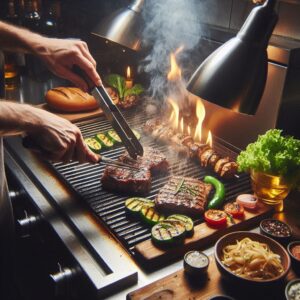5201.0413 Baked Chicken
Roasted and baked chicken in its many forms—rotisserie, traditional roast, and buffalo wings—is a staple in American and global cuisine. These preparations are not only culinary fundamentals but also highly adaptable, cost-effective items that support a wide range of menu formats from casual dining to high-volume catering. For chefs, mastering each style means understanding the science of moisture control, heat application, and flavor layering.
Rotisserie Chicken in Foodservice
Rotisserie chicken delivers high yield, strong customer appeal, and efficient labor cost. In retail and restaurant settings, it’s a reliable centerpiece for grab-and-go meals, plated entrees, and repurposed menu components.
From a culinary perspective, rotisserie cooking is prized for its ability to produce juicy, evenly cooked chicken with a golden, flavorful skin.
- Seasoning and Flavor Strategy: Dry rubs using coarse salt, black pepper, smoked paprika, garlic powder, and dried herbs penetrate the skin during rotation. Aromatics such as lemon halves, rosemary, or bay leaves can be placed in the cavity to infuse the meat with subtle layers of flavor.
- Cooking Logistics: Most commercial rotisserie ovens allow for batch cooking, with programmable settings that ensure consistent results. Rotisserie birds benefit from dry brining or marinade injections, depending on throughput and time.
- Yield Management: A 3.5–4 lb bird yields approximately 48–52% edible meat. Trimmings can be used in chicken salad, enchiladas, pot pies, or stock, minimizing waste and increasing profit.
- Menu Integration: Sliced rotisserie chicken is ideal for salads, wraps, bowls, sandwiches, and pasta. The bones and carcasses provide rich base stock, supporting soups and sauces.
Roast Chicken as a Culinary Benchmark
Roast chicken is often used to assess a chef’s ability to control temperature, moisture, and seasoning. It appears in a wide range of restaurant concepts—from classic French service to rustic bistros.
- Flavor Development: Butter or olive oil brushed over the skin creates a desirable browning effect via the Maillard reaction. Aromatics such as garlic, thyme, lemon, and bay leaf can be roasted in the pan to flavor both the chicken and the jus.
- Execution Tactics: Starting at a high temperature (425°F) to set the skin, then reducing to 375°F, balances browning and internal moisture. A thermometer should be inserted at the thickest part of the thigh, away from bone, to ensure doneness at 165°F.
- Resting and Carving: Allowing at least 10–15 minutes of rest redistributes juices and prevents loss during carving. Carving should follow the natural seams of the bird, maintaining clean presentation.
- Plating Formats: Whole-roast chicken can be served family-style or broken down into airline breasts, leg quarters, or boneless components. Accompaniments such as roasted root vegetables, garlic mashed potatoes, or pan jus elevate the dish’s appeal.
- Profit Strategy: Whole birds purchased in volume offer better food cost than boneless, skinless cuts. Roasted chicken is highly adaptable across ethnic menus (e.g., Mediterranean with oregano and lemon; Latin with achiote and garlic).
Baked Chicken Parmesan
Chicken Parmesan remains a mainstay of Italian-American menus, often served as a plated entrée or sub sandwich. It combines breaded chicken with marinara and cheese, then finished in the oven to meld components.
- Service Formats: Commonly paired with pasta or served over garlic bread as a hot sandwich, it is suitable for family-style dining and catered events.
- Operational Advantages: Par-baked or pre-breaded cutlets can be used during service rushes. Modular assembly allows for scaling during high-volume operations without sacrificing quality.
- Cross-Utilization: The same components—cutlets, sauce, mozzarella—can be used in lasagna, baked ziti, or pizza toppings, supporting menu cohesion.
Honey Mustard or Teriyaki Glazed Chicken
These glaze-driven preparations align with casual dining, catering, and quick-service menus. They offer familiar yet customizable flavor profiles that appeal to broad demographics.
- Flavor Adaptability: Honey mustard, teriyaki, bourbon glaze, or citrus-based glazes can be rotated seasonally or regionally. They balance sweetness, acidity, and umami.
- Protein Formats: Most effective with boneless, skinless chicken thighs or breasts. Glazes enhance visual appeal and support fast service when pre-portioned and batch baked.
- Catering Application: These dishes hold well in chafing dishes or warming boxes, making them suitable for office lunches, buffets, or drop-off catering.
Lemon Herb Roasted Chicken
This dish leverages citrus and fresh herbs to create a lighter roast profile that appeals to upscale and seasonal menus. It is often presented as a half chicken, airline breast, or boneless thigh over a starch base.
- Flavor Positioning: Emphasizes brightness, freshness, and aromatics. Often accompanied by pan jus or light wine-based reductions.
- Plating Styles: Appears frequently in prix fixe menus and white tablecloth dining. Complements spring and summer vegetables or light grains.
- Kitchen Execution: Herbs (e.g., thyme, oregano, tarragon) are inserted under the skin or mixed into compound butters. Oven roasting at moderate temperatures maintains protein structure and color.
Buffalo Wings: Technique and Versatility
Buffalo wings remain one of the most profitable items in American casual dining. Low cost, fast preparation, and broad flavor flexibility make them ideal for dine-in, takeout, and catering formats.
- Crisping Without Frying: Baking wings on wire racks allows fat to render and circulate. A dusting of baking powder (not baking soda) changes the skin’s pH and improves browning.
- Sauce Ratios and Behavior: The base buffalo sauce typically uses a 2:1 ratio of hot sauce (such as Frank’s RedHot) to melted butter. Garlic powder, vinegar, and cayenne may be added to adjust heat and acidity. Sauce should be added after baking to preserve skin texture.
- Flavor Variants: Wings can be adapted with sauces ranging from Korean gochujang to lemon pepper butter, honey mustard, or garlic parmesan. Offering multiple styles increases customer engagement and supports menu diversity.
- Serving Formats: Wings are commonly offered in 6, 10, or 12-piece portions. Accompaniments like celery, blue cheese, or ranch dressing are expected. Serving in shareable trays increases appeal for group dining and bar menus.
Sauces and Sides to Elevate Chicken Dishes
While the core chicken preparations are essential, sauces and sides complete the guest experience and influence perceived value.
- Roast Chicken: Serve with a pan jus, mushroom cream sauce, lemon-thyme reduction, or herb compound butter.
- Rotisserie Chicken: Pairs well with chimichurri, mustard vinaigrette, or smoky barbecue sauce.
- Buffalo Wings: Complement with creamy dressings, pickled vegetables, or dipping sauces (ranch, honey mustard, chipotle mayo).
- Suggested Sides for Plated Service
- Roast chicken: gratin potatoes, green beans, couscous, grilled corn
- Rotisserie: pilaf, mixed greens, garlic bread
- Wings: seasoned fries, coleslaw, fried pickles
Applications in Menu Engineering
Chicken remains one of the most versatile proteins in foodservice. It provides high protein content, broad consumer appeal, and strong margins.
- High-Volume Readiness: Whole roasted or rotisserie chicken scales well for banquets, buffet lines, and retail counters.
- Dietary Flexibility: Skinless roast breast meets health-conscious customer needs, while wings or dark meat offer indulgence.
- Waste Minimization: Bones, pan drippings, and trimmings can be turned into stock, sauces, or secondary items.
Mastering the preparation of roast chicken, rotisserie chicken, and buffalo wings allows chefs to combine classical technique with practical kitchen economics. Each preparation highlights different aspects of poultry cookery—moisture control, browning reactions, flavor layering, and efficient protein utilization. For restaurants and catering businesses, these dishes offer reliability, profit potential, and endless room for menu creativity.


